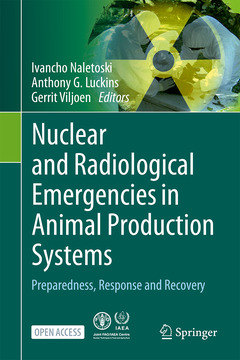Nuclear and Radiological Emergencies in Animal Production Systems, Preparedness, Response and Recovery, 1st ed. 2021
Coordonnateurs : Naletoski Ivancho, Luckins Anthony G., Viljoen Gerrit

This Open Access volume explains how major nuclear and radiological emergencies (NREs) can have implications at local, national and international level. The response to NREs requires a competent decision-making structure, clear communication and effective information exchange.
National veterinary services have the responsibility to plan, design and manage animal production system in their countries. These activities cover animal health, animal movement control, production control and improvement, and control of the products of animal origin before their placement on the market.
Release of radionuclides after NREs can cause substantial contamination in the animal production systems. Critical responsibility of veterinary authorities is therefore to prevent such contamination, establish early response mechanisms to mitigate the consequences and prevent placement of contaminated products of animal origin on the market for human consumption.
This work summarizes the critical technical points for effective management of NREs for national veterinary services.
Foreword (Author: LIANG Qu)
Preface (Author: All authors)
Table of Contents
About the Authors
List of Abbreviations
Chapter 1: National Veterinary Services Roles and Responsivities in Preparing for and Responding to Radiologic and Nuclear Emergencies (Author: Gary Vroegindewey)
Chapter 2: Basics of Radiobiology (Author: Victar Averin)
Chapter 3: Measurement of Radioactivity (Author: Victar Averin)
Chapter 4: Preparedness and Response to Nuclear and Radiological Emergencies in Animal Production Systems in the Context of IAEA Safety Standards (Author: Kevin Kelleher)
Chapter 5: General Patterns of Contamination of Animals and Animal Products after Nuclear and Radiological Emergencies (Author: Victor Averin)
Chapter 6: Environmental Pathways of Radionuclides to Animal Products in Different Farming and Harvesting Systems (Author: Brenda Howard)
Chapter 7: Management Options for Animal Production Systems- Which Ones to Choose in the Event of a Nuclear or Radiological Emergency? (Author: Anne Nisbet)
Chapter 8: Information Systems in Support of the Decision-Making Tools (Author: Joint Fao/Iaea Division)
Annex A: Worked examples to illustrate decision aiding framework (Author: Anne Nisbet)
Annex B: Datasheets on the Management Options (Author: Anne Nisbet)Open Access publication
This book, the first of its kind, summarizes the critical technical points for effective management of NREs for national veterinary services
Provides the decision-making tools for response to NREs
Date de parution : 06-2021
Ouvrage de 195 p.
15.5x23.5 cm



